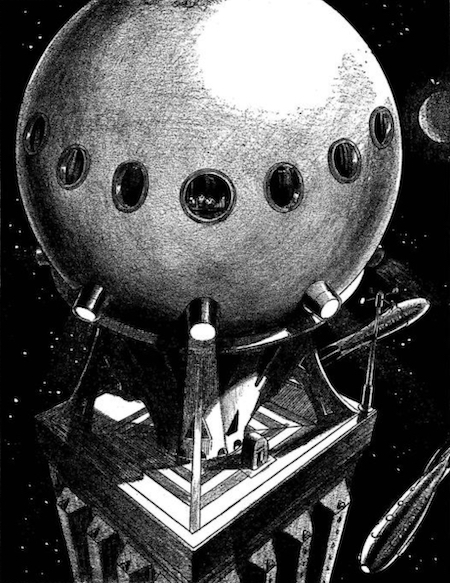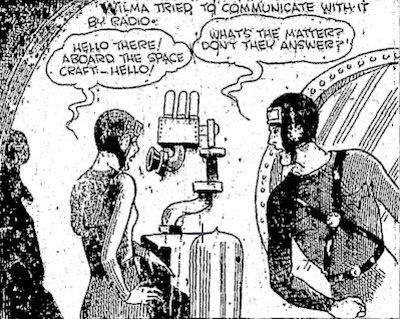Science Fiction
Dictionary
A B C D E F G H I J K L M N O P Q R S T U V W X Y Z
Latest By
Category:
Armor
Artificial
Intelligence
Biology
Clothing
Communication
Computers
Culture
Data Storage
Displays
Engineering
Entertainment
Food
Input Devices
Lifestyle
Living Space
Manufacturing
Material
Media
Medical
Miscellaneous
Robotics
Security
Space Tech
Spacecraft
Surveillance
Transportation
Travel
Vehicle
Virtual
Person
Warfare
Weapon
Work
"I went [to the top of] Vehicle Assembly Building and looked down, and tears burst from my eyes. The size of this cathedral where the Rockets take off to go to the moon is so amazing."
- Ray Bradbury
| Space Craft | ||
| A ship that travels through the airless void of space. |
As far as I know, the first use of this handy general phrase, published in July of 1929.
| Out There, all is cold — and the delight of perfect rest and exultation. So I was There, exulting in the chill which instruments can not measure, but only the soul, when I saw the first of the great space craft. “Aha!” I chuckled and rubbed my hands with heatless mirth. "Some of those inventors have slipped one over on me! I knew some fools were working on plans to penetrate space while yet they held to their corporeal forms — poor fools! But I didn’t know they had succeeded. Arko! I must see! There’s death in the making, and a cold death!” And I chortled. But too soon I knew the incredibly disagreeable truth. Not from Earth were those ships. No mortals, predestined to a cold death by their boldness. Those who guided the great cars had no dealings with death. They had lived for a trillion times a trillion years. Far older than I, they were. Small sustenance for my needs in such folk, and I would have darted off with a crackling curse, but a chance thought adrift in space crossed my brain, and I stayed. |
| Technovelgy from Night-Thing,
by Wilford Allen. Published by Weird Tales in 1929 Additional resources -
|
Raymond Z. Gallun is not far behind, providing lavish detail for the reader in his 1931 story Atomic Fire:
"That was a fine start, Chief," said Sark Ahar. "The
ship is gaining altitude faster than I ever saw a space
craft do before at the outset..."
Aggar Ho and Sark Ahar walked over to the center
of the landing stage. Here, supported by a funnel-shaped cradle was a big shiny sphere about seventy-five
feet in diameter. There was a row of circular windows
running horizontally around its circumference. Four
cylindrical objects, looking like some kind of searchlights, were set at equal intervals around its lower hemisphere. They pointed slantingly downward at an angle
of forty-five degrees with the platform. The globe was
a space-flier.
Aggar Ho opened an oval door in the side of the
craft. The two men ascended a short flight of metal
steps to the central chamber of the ship. The room,
which was lighted by port holes set all around its walls,
was packed with a bewildering outlay of scientific apparatus. At one side, before a large window, was the pilot
seat, and in front of it, a number of levers and a board
bearing many dials and instruments. It was by means
of these that the flier was controlled. The remainder
of the floor space was occupied by machinery and devices, and constituted a complete laboratory for exploring the inner secrets of atomic structure. In the center
of the room, supported by a sort of tripod, was a black
object which looked like a big pressure kettle. Many
cables and wires led to it from a bank of cylindrical
tanks which were filled with a fluid that supplied an electrical circuit of enormous voltage and amperage. There
was a work-bench running almost completely around
the walls of the laboratory, and on it were ranged many
odd instruments. There were queer microscope-like
devices for watching the electrons of atoms rotating in
their orbits; there were big glass globes for producing
strange rays ; there were several electric furnaces,
lathes and other machinery for turning out new apparatus whenever it was needed. Besides there was a
multitude of other things.
Aggar Ho seated himself in the pilot's chair while
Sark Ahar stood beside him. The old Martian shifted
a little lever on the control-board. A low musical hum
started from somewhere in the hulk of the ship ; in spite
of its faintness, it was somehow suggestive of an enormous and mysterious power. Now the space flier was
shooting upward. It swayed a little. The two men felt
their weight apparently increase; just as though they
were going upward on a fast elevator. The four repulsion-ray projectors, mounted on the bottom hemisphere of the craft, were sending powerful beams of
energy downward and were raising the big globe from
the ground.
An earlier use of this term can be found in this Buck Rogers: 2429 A.D. comic strip, published in October of 1929:
Details on Aerth's surface were growing rapidly
smaller and the field of view was broadening out.
Now Aerth looked like a great relief
map, and now it began to take on a slight outward
curvature. The scientist and his subordinate were
rapidly drawing away from their planet.

(Space Craft from 'Atomic Fire' by Raymond Z. Gallun)

(From Space Craft from 'Buck Rogers: 2429 AD)
The same year, 'Doc' Smith used it in Spacehounds of IPC:
Soon the surface of Europa lay beneath them; a rugged, cratered, and torn topography of mighty ranges of volcanic mountains. Most of the craters were cold and lifeless, but here and there a plume of smoke and steam betrayed the presence of vast, quiescent forces. Straight down one of those gigantic lifeless shafts the fleet of space craft dropped—straight down a full two miles before the landing signal was given. At the bottom of the shaft a section of the rocky wall swung aside, revealing the yawning black mouth of a horizontal tunnel.
Comment/Join this discussion ( 0 ) | RSS/XML | Blog This |
Additional
resources:
More Ideas
and Technology from Night-Thing
More Ideas
and Technology by Wilford Allen
Tech news articles related to Night-Thing
Tech news articles related to works by Wilford Allen
| Will Space Stations Have Large Interior Spaces Again? |
| Reflect Orbital Offers 'Sunlight on Demand' And Light Pollution |
| Chrysalis Generation Ship to Alpha Centauri |
| The First Space Warship For Space Force |
Want to Contribute an
Item?
It's easy:
Get the name of the item, a
quote, the book's name and the author's name, and Add
it here.
| <Previous | Next> |
|
|
|
Technovelgy (that's tech-novel-gee!) is devoted to the creative science inventions and ideas of sf authors. Look for the Invention Category that interests you, the Glossary, the Science Fiction Invention Timeline, or see what's New.
|
Science Fiction
Timeline
1600-1899
1900-1939
1940's 1950's
1960's 1970's
1980's 1990's
2000's 2010's
'Power could be compressed thus into an inch-square cube of what looked like blue-white ice'
'It's so light that you can set it up in five minutes by yourself...'
'Heavy penalties... were to be applied to any one found driving manually-controlled machines.'
'Buy a Little Dingbat... electropen, wrist watch, pocketphone, pocket radio, billfold ... all in one.'
'... an elastic, tinted material that had all the feel and appearance of human flesh and epidermis.'
'It is remarkable that the long leverages of their machines are in most cases actuated by a sort of sham musculature...'
